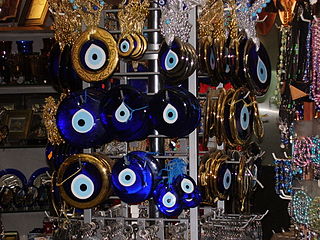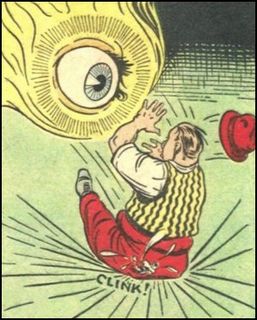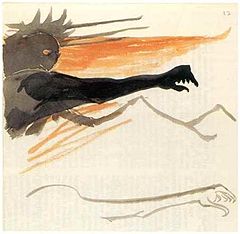 W
WBinocular O is one of the exotic glyph variants of Cyrillic letter O. This glyph variant can be found in certain manuscripts in the plural or dual forms of the root word eye, like Ꙫчи.
 W
WDouble monocular O is one of the exotic glyph variants of the Cyrillic letter O. This glyph variant can be found in certain manuscripts in the plural or dual forms of the word eye, for example ꙭчи "[two] eyes". They were incorporated into Unicode as characters U+A66C and U+A66D in Unicode version 5.1 (2008).
 W
WThe evil eye is a superstitious belief in curse, believed to be cast by a malevolent glare, usually given to a person when one is unaware. It dates back at least to Greek classical antiquity, 6th century BC where it appeared on Chalcidian drinking vessels, known as 'eye-cups', as a type of apotropaic magic. Many cultures believe that receiving the evil eye will cause misfortune or injury, while others believe it to be a kind of supernatural force that casts or reflects a malevolent gaze back-upon those who wish harm upon others. Older iterations of the symbol were often made of ceramic or clay; however, following the production of glass beads in the Mediterranean region in approximately 1500 BC, evil eye beads were popularised with the Phoenicians, Persians, Greeks, Romans and Ottomans. Blue was likely used as it was relatively easy to create; however, modern evil eyes can be a range of colors.
 W
WThe Eye is a fictional comic book character created by Frank Thomas and published by Centaur Publications. The character had no origin story, and existed only as a giant, floating, disembodied eye, wreathed in a halo of golden light. This powerful being was obsessed with the concept of justice, and existed to encourage average people to do what they could to attain it for themselves. If the obstacles proved too great, the Eye would assist its mortal charges by working miracles. Time and space meant nothing to the Eye and it existed as a physical embodiment of man's inner conscience.
 W
WThe Eye of Horus, wedjat eye or udjat eye is a concept and symbol in ancient Egyptian religion that represents well-being, healing, and protection. It derives from the mythical conflict between the god Horus with his rival Set, in which Set tore out or destroyed one or both of Horus's eyes and the eye was subsequently healed or returned to Horus with the assistance of another deity, such as Thoth. Horus subsequently offered the eye to his deceased father Osiris, and its revivifying power sustained Osiris in the afterlife. The Eye of Horus was thus equated with funerary offerings, as well as with all the offerings given to deities in temple ritual. It could also represent other concepts, such as the moon, whose waxing and waning was likened to the injury and restoration of the eye.
 W
WThe Eye of Providence is a symbol that depicts an eye, often enclosed in a triangle and surrounded by rays of light or Glory, meant to represent divine providence, whereby the eye of God watches over humanity. A well known example of the Eye of Providence appears on the reverse of the Great Seal of the United States, which is depicted on the United States one-dollar bill.
 W
WSauron is the title character and the primary antagonist, through the forging of the One Ring, of J. R. R. Tolkien's The Lord of the Rings, where he rules the land of Mordor and has the ambition of ruling the whole of Middle-earth. In the same work, he is identified as the "Necromancer" of Tolkien's earlier novel The Hobbit. The Silmarillion describes him as the chief lieutenant of the first Dark Lord, Morgoth. Tolkien noted that the Ainur, the "angelic" powers of his constructed myth, "were capable of many degrees of error and failing", but by far the worst was "the absolute Satanic rebellion and evil of Morgoth and his satellite Sauron". Sauron appears most often as "the Eye", as if disembodied.
 W
WA God's eye is a spiritual and votive object made by weaving a design out of yarn upon a wooden cross. Often several colors are used. They are commonly found in Mexican and Mexican American communities, among both Indigenous and Catholic peoples.
 W
WMonocular O is one of the rare glyph variants of Cyrillic letter O. This glyph variant was used in certain manuscripts in the root word ꙩко (eye), and also in some other functions, for example, in the word- and syllable-initial position. It is used in some late birchbark letters of the 14th and 15th centuries, where it is usually differentiated from a regular о, used after consonants, also by width, being a broad On (ѻ) with a dot inside.
 W
WMultiocular O is an exotic glyph variant of the Cyrillic letter O. This glyph variant can be found in certain manuscripts in the Old Church Slavonic phrase "серафими многоꙮчитїи". It was documented by Yefim Karsky from a copy of Psalms from around 1429, now found in the collection of the Trinity Lavra of St. Sergius. It was proposed for inclusion into Unicode in 2007 and incorporated as character U+A66E in Unicode version 5.1 (2008).